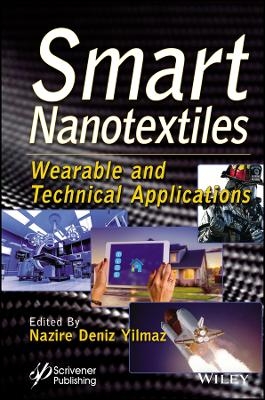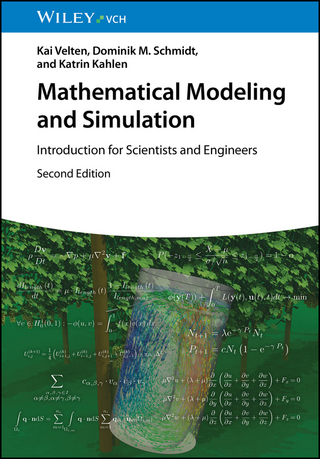
Smart Nanotextiles
Wiley-Scrivener (Verlag)
978-1-119-65478-0 (ISBN)
This book covers the emerging and exciting field of nanotextiles and their many applications. Smart nanotextiles form a novel group of materials that are utilized/can be utilized in an array of application areas, such as biomedicine (health monitoring, controlled drug release; wound care, and regenerative medicine), communication, sports, fashion, energy harvesting, protection, filtration, civil and geotechnical engineering, transportation, and so on, including wearable and technical fields.
Whereas textiles provide a convenient platform for smart functionality, nanotechnology assures that the favorable characteristics of the textile structure are not impaired by the smart functioning components. Furthermore, based on the superior characteristics of nanostructured components in comparison to macromaterials and micromaterials, nanomaterials provide augmented smart functionality. However, despite the immense research efforts that have been devoted to smart nanotextiles, most of them have not yet transcended the commercialization stage due to high cost, difficulty in large-scale production, low reliability, and potential detrimental effects of nanomaterials on human health and the environment.
The 12 chapters comprising this book are all written by subject-matter experts from around the world and discuss the next-generation products along with their challenges and opportunities.
Audience
Researchers, technologists, industrial engineers, and postgraduate students in the fields of textiles, intelligent materials, electronics, sensors, actuators, biomedicine, fashion, filtration, transportation, civil engineering, environmental engineering, communication, sports performance, and materials science, who have an interest in smart materials, nanotechnology and wearables.
Nazire Yilmaz obtained her PhD degree in Textile Technology Management program from North Carolina State University (NCSU), USA where she has also worked as a teaching assistant. Currently, she is an associate professor in the Textile Engineering Department at Uşak University in Turkey. She has published more than 30 research papers in peer-reviewed journals, 13 book chapters, and eight conference papers, and holds a patent. She is the editor of Smart Textiles: Wearable Nanotechnology (Wiley-Scrivener, 2018).
Preface xv
Section 1: Introduction 1
1 Smart Nanotextiles Applications: A General Overview 3
Nazire Deniz Yilmaz
1.1 Introduction 4
1.2 Textiles 7
1.2.1 Brief History of Smart Nanotextiles 8
1.2.2 Terminology 10
1.2.3 Classification 10
1.3 Nanotechnology and Nanomaterials 12
1.3.1 Nanomaterials 12
1.3.2 Nanocomposites 15
1.4 Materials Selection 16
1.4.1 Stretchability 16
1.4.2 Permeability 17
1.4.3 Self-Healing 17
1.4.4 Biocompatibility 18
1.4.5 Conductivity 18
1.4.6 Scalability 19
1.4.7 Energy Autonomy 19
1.4.8 Cost Efficiency 19
1.5 Sensors 19
1.5.1 Strain Sensing 20
1.5.2 Tactile Sensing 21
1.5.3 Temperature Sensing 21
1.5.4 Electrochemical Sensing 21
1.5.5 Humidity Sensing 21
1.5.6 Photo Sensing 22
1.5.7 Gas Sensing 22
1.5.8 Multisensing 22
1.5.9 Disposable Sensors 23
1.6 Application Areas of Smart Nanotextiles 23
1.6.1 Medicine and Healthcare 24
1.6.1.1 Health Monitoring 25
1.6.1.2 Drug Delivery 32
1.6.1.3 Wound Care 35
1.6.2 Everyday Applications of Smart Nanotextiles 39
1.6.2.1 Communication 39
1.6.2.2 Sports 43
1.6.2.3 Fashion and Aesthetics 45
1.6.2.4 Energy Harvesting 47
1.6.3 Technical Applications of Smart Nanotextiles 53
1.6.3.1 Protection and Defense 53
1.6.3.2 Filtration Applications 55
1.6.3.3 Civil and Geotechnical Engineering Applications 58
1.6.3.4 Transportation Applications 62
1.7 Risks and Opportunities 64
1.8 Conclusion 69
References 70
Section 2: Smart Nanotextiles for Medicine and Healthcare 87
2 Smart Nanotextiles for Wearable Health Monitoring 89
Shanshan Yao, Shuang Wu and Yong Zhu
2.1 Introduction 90
2.2 (Bio)Physical Monitoring 102
2.2.1 Body Temperature 102
2.2.2 Biopotential Signals 106
2.2.3 Blood Pulse 108
2.2.4 Blood Pressure 110
2.2.5 Respiration Rate 112
2.3 (Bio)Chemical Monitoring 114
2.3.1 Biofluids 114
2.3.2 Breath and Body Odor 117
2.4 Multimodal Monitoring 119
2.4.1 Multimodal Monitoring of Physical Biomarkers 119
2.4.2 Multimodal Monitoring of Physical and Chemical Biomarkers 122
2.5 Conclusions and Future Remarks 123
Acknowledgments 124
References 124
3 Smart Nanotextiles for Controlled and Targeted Drug Release 135
Rauf Mahmudzade, Caroline Werther, Dilip Depan and Raj Pal Singh
3.1 Nanomaterials and Drug Delivery Systems 136
3.2 Graphene: Properties and Applications in Biomedicine 137
3.3 Toxicity Studies of Graphene-Based Nanomaterials 139
3.3.1 Pristine Graphene 140
3.3.2 Graphene Oxide 141
3.4 Graphene Quantum Dots: Properties and Potential in Theranostics 142
3.4.1 Biological Properties of Graphene Quantum Dots 144
3.4.2 Optical Properties of Graphene Quantum Dots 145
3.4.3 Therapeutic Applications of Graphene Quantum Dots 146
3.4.4 Imaging Applications of Graphene Quantum Dots 148
3.5 Conclusion and Final Remarks 150
Acknowledgments 151
References 151
4 Smart Nanotextiles for Wound Care and Regenerative Medicine 159
Sadiya Anjum, Rashid Ilmi and Imran Khan
4.1 Introduction 159
4.2 Nanotextiles in Healthcare Materials 162
4.2.1 Nanotextiles in Wound Dressing 162
4.2.1.1 Herbal Extract–Loaded Nanofibers 163
4.2.1.2 Natural Products 165
4.2.1.3 Antibiotics 167
4.2.1.4 Nanoparticles (NPs) 169
4.2.2 Suture Materials 170
4.2.3 Tissue Engineering and Regeneration 174
4.2.3.1 Skin Tissue Engineering 174
4.3 Conclusions and Future Perspectives 179
References 180
Section 3: Smart Nanotextiles for Everyday’s Life 189
5 Smart Nanotextiles for Communication 191
Isidoro Ibanez-Labiano, Syeda Fizzah Jilani, Ronald Rui Zhang, Elif Ozden-Yenigun and Akram Alomainy
5.1 Introduction 192
5.1.1 Nanocommunications 193
5.1.2 Smart Textiles Communications 195
5.2 Textile Wearable Devices 196
5.2.1 Nanoengineered Textile Antennas and Their Applications: Nanoparticles on Textiles 196
5.2.1.1 Characteristics of Metallic Inks and Fibers 197
5.2.1.2 Characteristics of Nonmetallic Carbon-Based Inks and Fibers 197
5.2.2 Integration Processes for Smart Nanotextiles (Metallic and Nonmetallic Materials) 198
5.2.3 Smart Textile Antennas 198
5.2.3.1 Graphene-Soft Antenna 198
5.2.3.2 Inkjet-Printed Millimeter Wave PET-Based Flexible Antenna 203
5.2.3.3 Tera-Hertz Wearable Antenna 209
5.3 Nanoscale Body-Centric Communications 211
5.3.1 Terahertz Wave Propagation for In Vivo Nanonetworks 212
5.3.1.1 Theoretical and Analytical Considerations 212
5.3.1.2 Molecular Absorption 213
5.3.1.3 Path Loss 214
5.3.2 Molecular Absorption Noise Model 216
5.3.2.1 Free Space Scenario 216
5.3.2.2 In Vivo Scenario 218
5.4 Challenges and Future Prospects 221
5.5 Conclusion 222
Acknowledgment 223
References 223
6 Smart Nanotextiles for Sports 229
Tim Smith, James Lee and Daniel A. James
6.1 Introduction 230
6.2 Trends 231
6.2.1 Wearable Technology 231
6.2.2 Convergence 232
6.2.3 Mass Market Driving Down Costs 232
6.2.4 Miniaturization 233
6.3 Textile Innovation 233
6.3.1 Passive 235
6.3.2 Active 235
6.3.3 Smart Technologies 236
6.4 Enabling Technologies 237
6.4.1 Microsystems 237
6.4.2 Power Systems 237
6.4.3 Where is the Market Now? 238
6.5 Discussion and Conclusions 244
References 245
7 Smart Nanotextiles for Fashion and Aesthetics 249
Mei Yu Yao, Jennifer Xiaopei Wu and li li
7.1 Introduction 249
7.2 Smart Textiles for Fashion and Aesthetics 250
7.3 Nanotechnology in Smart Textiles 252
7.3.1 Enhancing Durability and Functions of Textiles 252
7.3.2 Electrical Conductivity 253
7.4 Examples of Smart Nanotextiles on Mainstream Fashion 255
7.4.1 Hygiene and Protection 255
7.4.2 Connectivity 257
7.4.3 Sustainability 257
7.5 Challenges for Smart Textiles with Nanomaterials 258
7.6 Future Trends of Smart Nanotextiles 259
7.6.1 Wearable Energy Storage Devices and Regenerative Energy 259
7.6.2 Technology of Artificial Intelligence (AI) 259
7.6.3 3D Printing Technology 260
References 260
8 Smart Nanotextiles for Energy Generation 265
Jiaqing Xiong and Pooi See Lee
8.1 Introduction 266
8.2 Textiles Nanogenerators 267
8.2.1 Thermoelectric Fibers/Textiles 267
8.2.2 Piezoelectric Fibers/Textiles 268
8.2.3 Triboelectric Fibers/Textiles 269
8.3 Progress and Application of Textile Nanogenerators 270
8.3.1 Thermoelectric Generators 270
8.3.1.1 Thermoelectric Generator for Energy Harvesting 271
8.3.1.2 Thermoelectric Generator for Self-Powered Sensing 274
8.3.2 Piezoelectric Nanogenerators 275
8.3.2.1 Inorganic Material–Based Piezoelectric Fibers/Textiles 276
8.3.2.2 Polymer-Based Piezoelectric Fibers/ Textiles 278
8.3.2.3 Structure Modification for Piezoelectricity Enhancement 279
8.3.2.4 Active Component Modification for Piezoelectricity Enhancement 280
8.3.2.5 Applications and Challenges of Piezoelectric Fibers/Textiles 281
8.3.3 Triboelectric Nanogenerators 282
8.3.3.1 Fiber/Textile-Based Power Sources 283
8.3.3.2 Fiber/Textile-Based Self-Powered Wearable Systems 285
8.3.3.3 Applications and Challenges of Triboelectric Fibers/Textiles 288
8.4 Hybrid Devices for Energy Harvesting and Storage 292
8.5 Conclusions and Prospects 294
References 295
Section 4: Smart Nanotextiles for Industrial Applications 311
9 Smart Nanotextiles for Protection and Defense 313
Unsanhame Mawkhlieng and Abhijit Majumdar
9.1 Introduction 313
9.2 Protective Textiles 316
9.2.1 UV Protection 316
9.2.2 Protection Against Bacteria 320
9.2.2.1 Types of Antibacterial Materials 321
9.2.2.2 Inorganic Nanomaterials Used for Antibacterial Activity 322
9.2.3 Flame Protection 325
9.2.3.1 Inorganic Nanomaterials for Flame Retardancy 325
9.2.4 Extreme Cold Protection 327
9.2.5 Nuclear Biological and Chemical (NBC) Suits/Hazmat Suits 329
9.2.6 Ballistic Protection 330
9.3 Conclusion 332
References 333
10 Smart Nanotextiles for Filtration 341
Mohd Yusuf and Amit Madhu
10.1 Introduction 341
10.2 Process of Filtration and Properties of Filter Media 343
10.3 Operating Parameters of Filtration 348
10.4 Applications of Smart Nanotextiles in Filtration 350
10.4.1 Contaminants and Heavy Metal Ions Removal from Water Systems 350
10.4.2 Smart Air Filter 351
10.4.3 COVID-19 Scenario: Protective Face Masks 352
10.4.4 Oil Removal Applications 354
10.4.5 Conclusions and Future Outlook 355
References 355
11 Nanotextiles in Civil and Geotechnical Engineering 359
A. F. M. Fahad Halim, Nazia Nourin Moury and Mohammad Tajul Islam
11.1 Introduction 359
11.2 Geosynthetics 362
11.2.1 Properties of Geosynthetics 362
11.2.1.1 Physical Properties 363
11.2.1.2 Mechanical Properties 363
11.2.1.3 Hydraulic Properties 364
11.2.1.4 Durability Properties 364
11.2.1.5 Degradation 364
11.2.2 Types of Geosynthetics Used in Civil and Geotechnical Engineering 365
11.2.2.1 Green Geosynthetics 365
11.2.2.2 Composite Geosynthetics 366
11.2.2.3 Smart and Active Geosynthetics 367
11.3 Common Traditional Applications of Geosynthetics in Civil and Geotechnical Engineering 368
11.3.1 Managing Shoreline Changes as a Result of Rising Sea Levels 368
11.3.2 Reinforcement of Unpaved Roads 369
11.3.3 Geosynthetic-Reinforced Soils Above Voids 369
11.3.4 Development of Dune Sand 370
11.3.5 Geotextile-Reinforced Slope Subject to Drawdown 370
11.4 Nanomaterial Application to Geosynthetics for Civil and Geotechnical Engineering 371
11.4.1 Fiber Optical Nanosensors for Temperature/ Strain Sensing 374
11.4.2 Carbon Nanofibers Aggregate Sensors 376
11.4.3 Nanoporous Thermal Insulation (NTI) 376
11.4.4 Phase-Change Materials 378
11.4.5 Nanoclay Polymer Composites 379
11.4.6 Thermochromic Roof System 380
11.4.7 Smart Houses, Smart Roads, and Smart Cities 381
11.5 Conclusion 384
References 384
12 Smart Nanotextiles for Transportation 391
Cédric Cochrane and Francois Boussu
12.1 Introduction 392
12.2 Sensor Yarns for Composite Materials 395
12.2.1 Optical Fiber Sensors 395
12.2.2 Fibrous Sensors 396
12.2.3 Matrix of Sensors 400
12.3 Development and Application of Various Fibrous Sensor Yarns 401
12.3.1 Piezo-Resistive Sensors Coated on Fabric 402
12.3.2 Fibrous Sensors Made From Continuous Yarns 403
12.3.3 Design and Production of Sensor Yarns 403
12.3.3.1 Calibration of Sensor Yarns 404
12.3.3.2 Manufacturing of 3D Fabric With Sensor Yarns 406
12.3.3.3 Composite Manufacturing Process of 3D Fabrics With Embedded Sensor Yarns 406
12.3.3.4 Quasi-Static Characterization and Monitoring of Composite Material 408
12.3.4 Fibrous Sensors Made From Commingled Yarns 413
12.3.4.1 Design and Production of Sensor Yarns 413
12.3.4.2 Calibration of Sensor Yarn 416
12.3.4.3 Forming of 3D Fabrics With Embedded Sensor Yarns for Monitoring 418
12.4 Discussion 422
12.5 Conclusion, Perspectives and Suggestions of Future Works 425
References 426
Index 431
| Erscheinungsdatum | 15.07.2022 |
|---|---|
| Sprache | englisch |
| Maße | 10 x 10 mm |
| Gewicht | 454 g |
| Themenwelt | Naturwissenschaften ► Chemie |
| Technik ► Maschinenbau | |
| ISBN-10 | 1-119-65478-5 / 1119654785 |
| ISBN-13 | 978-1-119-65478-0 / 9781119654780 |
| Zustand | Neuware |
| Informationen gemäß Produktsicherheitsverordnung (GPSR) | |
| Haben Sie eine Frage zum Produkt? |
aus dem Bereich


